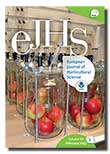

European Journal of Horticultural Science

Antioxidative Reactions Inducing Tolerance to Severe Dehydration in Tepary Bean ( Phaseolus acutifolius )
Authors
M. F. Mohamed ; M. Schmitz-Eiberger ; G. Noga ; Institut für Obstbau; Gemüsebau, Universität Bonn, Bonn, Germany; Department of Horticulture, Faculty of Agriculture, Assiut University, Assiut, Egypt
Summary
Two tepary (TB) bean lines (NE#19 and NE#5) were subjected to progressive water depletion and rewatering (RW). Under a condition of mild water depletion (MWD), the leaf relative water content (RWC) was similar in both lines and did not significantly differ from the respective well-watered (WW) seedlings. Line NE#19 under MWD conditions significantly increased stomata resistance and reduced transpiration rate compared to WW seedlings. Also it showed tendency towards reduction in the intercellular CO2and elevated net photosynthesis. Its stem and root mass, specific leaf mass (SLM) increased while the portion of leaf area to 1 mg dry root mass (LA/RDM) decreased compared to the WW ones. NE#5 did not show such changes in gas exchange and plant growth parameters under MWD conditions when compared to the WW. Tocopherols (TPH) increased under MWD conditions but no changes occurred in malondialdehyde (MDA) and chlorophyll (Chl) content. Carotenoid and ascorbic acid (AA) contents in NE#19 and peroxidase (POD) activity in NE#5 increased. The rewatered (RW) seedlings showed a decline in TPH and MDA in both TB lines. AA decreased while carotenoid content remained high in NE#19. POD activity increased in NE#5. The fluorescence parameter Fv/Fmwas higher under both MWD and RW than WW conditions for NE#5 but the change in NE#19 was not significant. When subjected to severe water depletion (SWD), the RWC significantly decreased and both TB lines suffered severe dehydration in spite of 11 % higher RWC in NE#19 than in NE#5. Compared to the respective WW, both lines had a significant sharp reduction in plant growth (leaf, stem and root) and SLM. However, NE#19 significantly exceeded the WW in LA/RDM and R/S ratio when subjected to SWD. TPH contents in severely dehydrated leaves were 2 (NE#5) to 3 (NE#19) folds the level in the WW ones. NE#5 showed an increase in POD activity but AA contents decreased. In contrast, POD activity in NE#19 did not elevate while AA significantly declined. Chl and carotenoid contents decreased in both lines. While fluorescence parameter Fv/Fmdecreased in both TB lines, the F0showed stability only in NE#5. After the rehydration, NE#19 remained showing high level of TPH and MDA, a decrease in Fv/Fmand an increased F0value. This occurred in spite of the elevated AA content. Distinctively NE#5 showed a recovery after rehydration and it is regarded as a more tolerant to withstand severe water deficit than NE#19.
Download full-text version (PDF 716019 bytes)
Keywords
ascorbic acid; Chl a fluorescence; drought tolerance; germplasm; oxidative stress; peroxidase
